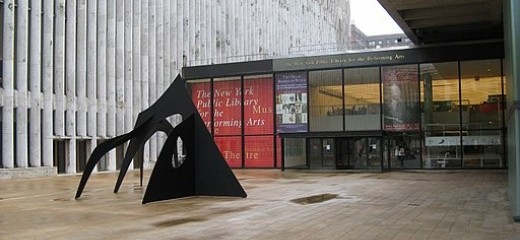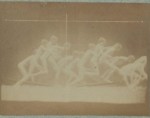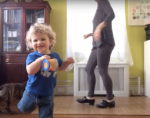
Tormented Genius: Jerome Robbins
by Lynn Matluck Brooks
A man of many parts—dancer, choreographer, director, visual artist, writer, activist, life-long learner, and more—Jerome Robbins was also a man of many demons.1 These facets of Robbins, who died in 1998, became more finely etched for me as I listened to the presentations at the 2018 Research Fellowship Symposium, “Celebrating the Life and Work of Jerome Robbins,” at the New York Public Library for the Performing Arts (NYPL) at Lincoln Center.
Why this symposium, now? This year, 2018, is the one hundredth anniversary of Robbins’ birth, and many ballet companies worldwide are celebrating by presenting his works (Pennsylvania Ballet may do so a year later—Spring 2019). Next time I see his choreography—live or on screen—I’ll be looking at it differently, having heard the papers by the NYPL Dance Research Fellows. All the Fellows were selected for their focuses on the life and work of Robbins, who choreographed for American Ballet Theatre, New York City Ballet, Broadway, and Hollywood. He was also a great supporter of NYPL’s remarkable Dance Division; in fact, it was eventually named for him.
The six presenters were a knowledgeable and varied group, from students to teachers, artists to writers, dancers to critics. Their perspectives on the variegated Robbins made for a kaleidoscopic symposium, but somehow all the pieces jigsawed into a mostly coherent puzzle as the day wore on. Alistair Macaulay, dance critic of The New York Times, started the program by comparing Robbins’ 1953 choreography for L’Après-midi d’un Faune with that of Vaslav Nijinsky (1912), noting where the two works differed and where, surprisingly, they shared commonalities in conception, choreography, and production. Most fascinating was the film footage he shared of the Robbins work danced by various casts, and the discussions Macaulay recorded among dancers who had been in the work. They offered insights into the dance movement, the meanings they found in it, and their memories of the work and its maker. Also looking at Robbins the choreographer was dance writer Robert Greskovic, who explored five ballets Robbins created to the music of Frédéric Chopin, including such masterpieces as The Concert (1956) and Dances at a Gathering (1969). Greskovic’s research included evolutions of the works’ designs, presentations, and reception. Again, film footage (from NYCB performing The Concert on The Ed Sullivan Show) was a highlight of this presentation, revealing Robbins’ wit, deep musicality, and dramatic sensibility.
Two presenters studied Robbins’ considerable skill as a visual artist, which he practiced through drawing, painting, and photography. Dancer/photographer Julie Lemberger focused on this last mode, which, she pointed out, stops movement and time—exactly opposite to the objectives of choreography. Yet, photography creates part of the precious “paper trail,” as Lemberger called it, that allows us to track dance historically. Here she looked at the ways that renowned dance photographer (and ballet dancer) Martha Swope recorded Robbins’ work, particularly rehearsals of West Side Story as he was creating it. This perspective Lemberger contrasted with Robbins’ own photography, as he recorded his work, travels, and self (he often shot his dancers backstage, looking into a mirror, allowing him to capture both them and himself photographing them). He was a serious practitioner, even developing his film in a home darkroom. Presenter Ninotchka Bennahum, on the other hand, announced a broad theme: “Jerome Robbins’ Painterly Eye: War, Exile, and the Founding of American Ballet Theatre.” While she started off with the intriguing comment that no art historian has looked seriously at Robbins’ large output of sketches, pastels, and paintings—a couple of which her slides displayed—she jumped to his fleeing of personal demons (Jewishness, homosexuality, leftist politics, loneliness), his travels (particularly to Mexico and Jacob’s Pillow), his relationships with various figures in the founding of [American] Ballet Theatre, and the influence on his work of British choreographer Antony Tudor. I was left unsure how to connect these many strands and longing to know more about just what she started with—Robbins’ art work.
Language was the focus of the two remaining presentations. With crystalline clarity, dance writer and teacher Hiie Saumaa illuminated Robbins’ lifelong commitment to writing—in journals, poems, short stories, scripts, articles, and other formats. She shared with us not only the questions that motivated her study, but also the themes that emerged from it: the inner landscapes Robbins explored, his voyeuristic stance, his restless yearnings for other places, his loneliness. Stunning to see were the images Saumaa shared of Robbins’ diaries, which he maintained from 1971 to 1984. Each accordion-constructed notebook included his memories, moods, fears, travels; drawings of nature, figures, household items; glued-in collages of plants, stamps, photos, menus; and multiple colors, directions of writings, and geometric forms created by his words. The journals are beautiful puzzles (like the man himself), works of art in their own right—full of whimsy, anxieties, meditations, creative exploration, and intimacy (he addressed the reader as “you” throughout, suggesting he knew he had an audience even for his diaries). For Robbins, the blank page was, like the blank stage, a place for invention.
Closing the day’s presentations was NYCB principal dancer Adrian Danchig-Waring, who explored Robbins’ movement vocabulary in an effort to bring “Jerry’s” presence as much into the “mythology” (his words) of NYCB’s culture and community as George Balanchine’s has long been. As Danchig-Waring pointed out, doing the dances themselves, as he has, opens a portal to Robbins’ language, to his life, his creativity, and fears—those demons that pursued him, pushed him, and shaped the chiaroscuro of his prodigious output. In an oral-history project with dancers who worked directly with Robbins, Danchig-Waring is seeking the very words that Robbins used in creating and rehearsing his ballets, so that this language can illuminate the choreographer’s movement language even further. A delightful presenter, Danchig-Waring was the fitting capstone to this day in honor of one of the twentieth-century masterminds of movement.
The 2018 Research Fellowship Symposium: Celebrating the Life and Work of Jerome Robbins, New York Public Library for the Performing Arts, January 26.
1 In fact, an early biography of Robbins was titled Dance with Demons: The Life of Jerome Robbins, by Greg Lawrence (2001). See also Deborah Jowitt, Jerome Robbins: His Life, His Theater, His Dance (2005) and Amanda Vaill, Somewhere: The Life of Jerome Robbins (2008).
By Lynn Matluck Brooks
February 4, 2018









